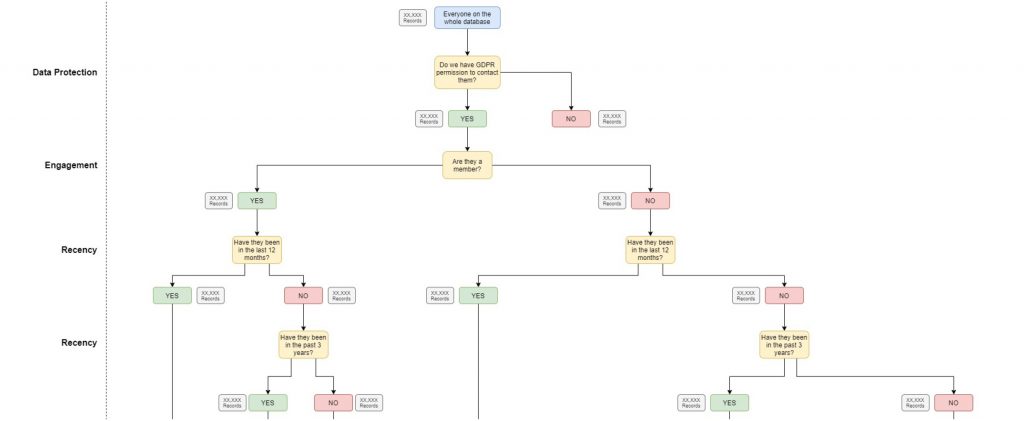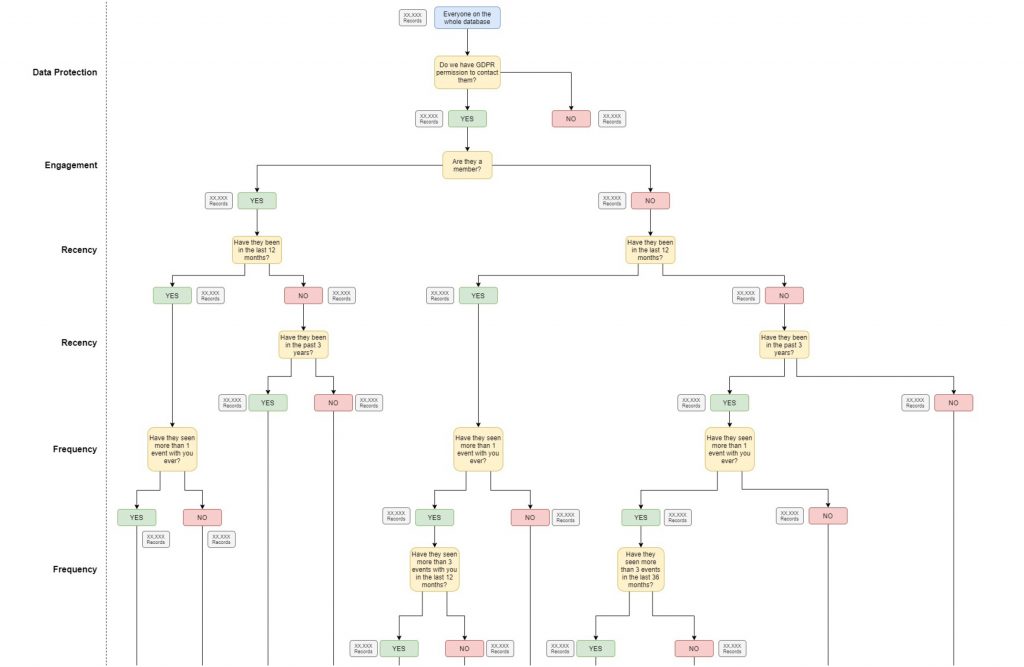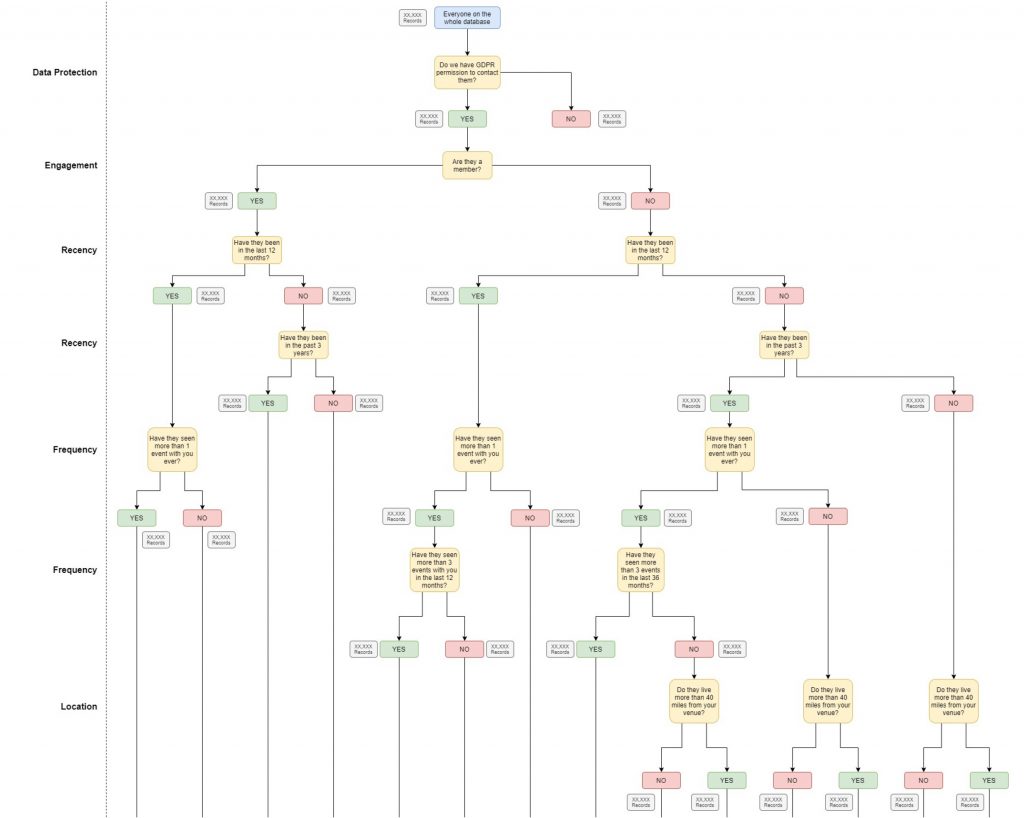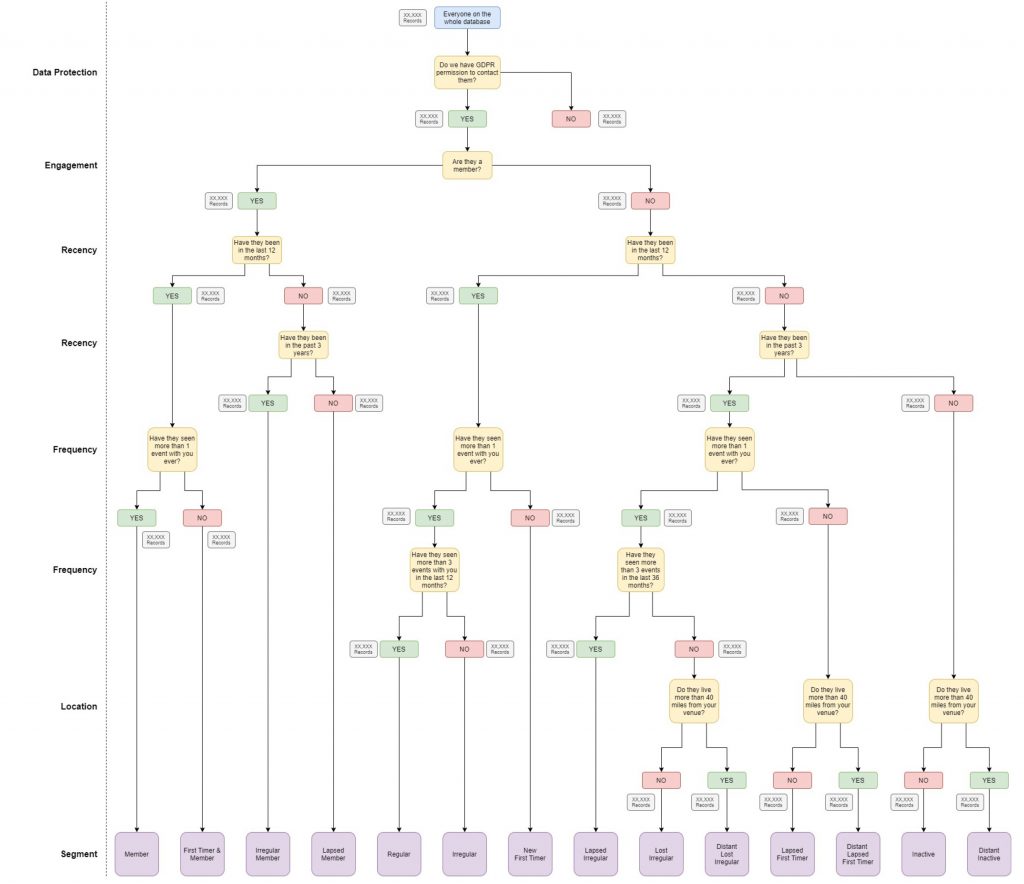Hi, welcome back if you’ve been to my blog before, and if you’re new (which statistically speaking you probably are) welcome too. This is a bit of a blog I decided to write as my spare time is still pretty bountiful. If you enjoy this or it’s useful* then please tweet me, Linkedin message me or comment at the bottom of the post (it’s dead easy!) – I’ll probably reply and it’ll make me feel a bit more confident writing these things (I frequently feel like a fraud, after all I’m no consultant**) and, hey, everyone likes someone to say “hello” to them every now and then. Oh, or share it, that’s also nice.. Cheers, Sam Xx
*it’s unlikely to be both enjoyable and useful
**particularly at the moment, the last 2 weeks have felt like a slog
Another Long Introduction
I’ve been reading a few blogs on Linkedin recently about arts marketing (something which, as a rule I tend to avoid) – they all had titles like “5 tips to Covid-19 marketing” or “3 ways to market you organisation out of Coronavirus” or, too ambitiously, “101 great marketing tips for the new normal”. Now I’m conscious that I blog fairly regularly and I have written various pieces about What The Fuck We Do Now (paraphrased title – most of them are ageing horrendously quickly) and I’ve mostly avoided numbering them but I’m very conscious that potentially slagging off other writers on the subject is dangerous, potentially hypocritical and maybe even dangerously hypocritical.
So I’m not going to slag them off. Sorry.
Those blogs take a big picture approach, they are (mostly) it seems to me (mostly) correct – advocating listening, planning flexibly and segmenting. In fact segmentation is the thing that’s mentioned time after time and it occurred to me that, while lots of people talk about it, very few people give any practical advice about how to do it.
So I thought I’d write a bit about how (and why) I do it. There will be many people who disagree, have better ways or think it’s wrong, and they are completely entitled to write their own excessively long, rambling, expletive-laden blog to a small non-returning audience as well – this is simply what I think.
You may disagree, that’s okay.
When I first started in #ArtsMarketing (it has a hashtag now btw…) before Arts Marketing even had a hashtag I had no idea what segmentation was – apart from perhaps in relation to oranges, or, more specifically, clementines. So let’s start there.
Citrus Fruits And Segments
Segmentation is about taking your total full database (the clementine) and breaking that complete thing into smaller manageable parts (the segments) to develop a more bespoke relationship so that you get a better return (juice). You don’t try swallowing a clementine whole as it would, in all likelihood, choke you to death, whereas the segments of a peeled clementine offer an altogether nicer, juicier, stickier result.
Indirect Lesson #1 – Always peel a clementine.
The mailing example is a good starter – if you have 100,000 people on a mailing list you can’t, in all likelihood, afford to send all of those people a season brochure or letter. What you want to do is narrow it down to those people who offer the biggest potential return, (either immediately or in the future – we’ll come on to new bookers later) – so you might look at a number of factors to determine how you can get to a manageable level…
You might look at
- Genre – What type of shows did they come and see? Drama, comedy, historical re-enactment, contemporary, classical?
- Recency – Did they come last week or has it been 10 years since they last took a step through your doors?
- Frequency – Do they come once a year or are they practically living at the place?
- Spend – Do they spend a lot or a little?
- Booking Time – Do they book early or late?
- Booking channel – are they ringing box office for lovely chats and recommendations or are they keyboard warriors online?
- Location – Do they live near to you or are they people willing to travel?
- Demographic – How old are they? Young? Elderly?
- Engagement – Are they members, or have they made a donation to the cause?
- GDPR/Data Protection – The dreaded word(s) – are they actually happy for you to contact them in the first place?
- First Timer – Have they only visited once (and yes, I know this could also go under frequency…)
All of these can help reduce your initial list of 100,000 people into smaller chunks, it could be 100 lists of a thousand, or 1,000 lists of a hundred. The problem with all these segmentations is that they’re all flawed in some sort of way. Examples?
- Someone whose seen classical music last time they visited might have hated it – if you send them more classical music then they might hate you too.
- Someone might have spent loads at your venue but not felt like they got value for money (“The show was expensive but a pile of crap”) – they might be very unwilling to return.
- Someone might not have booked for years but that’s because they moved to the Loire Valley in France for 10 years to open a wine merchants after falling in love with a local woman in a small village bistro. They subsequently got married, fell out, she left them for Pierre (who’s a merchant banker from Lyon) and they returned to their home before it all went wrong and they just need a little communique to tip them into visiting and you’ve come in all heavy handed asking them to buy 10 shows.
- I love stand up comedy (true) but I’m also a massive fan of Chopin (this is also true by the way) and love physical theatre (I’m eclectic and modest). I despise Shakespeare (very true), but my booking record shows that I go and see the dead-has-beens work periodically so that I fit in with my arty friends (not fully true, I also go so that I can continue to remain aloof while also being well informed about the dead-has-been). I also love Chekhov – particularly the plays about middle-age men feeling lost, dreaming and reminiscing – I’m not sure why. What do you send me and how do you know?
It’s impossible. The dream of course is to have a segment of one for each person on your database, our knowledge and skill ensuring that everyone gets what they need personalised and delivered in the perfect way at the perfect time in the perfect format. The reality is that, certainly in theatres, we work to deadlines, we don’t have enough time and we need to work in a way that’s manageable within the resource we have.

Unlike people they live in trees, surrounded by lightbulbs.
What segments to use
You can, of course, use any combination of those potential segments – many others are available. I’ve also not touched on many of the segmentation models offered by some very accomplished marketing consultancies that look at motivation or the type of person you are. I’ve not touched on it because I don’t know enough about it – you should investigate – I’ve always felt that evidence of success seems a little light on the ground, the ability to implement simply and practically a little beyond the realms of most people’s realities and they always, always have silly names. That’s not to say they don’t work for some organisations, undoubtedly incredibly well*.
*This whole paragraph is bound to get me in trouble, I was going to delete it, but I’m always happy to have my mind changed… Apart from the silly name thing, I’m sticking with that.
The four/five which I’m going to focus on (as a theatre-specific arts marketeer) are: Frequency, Recency, Engagement & Location (and of course Data Protection). If you’re an experience arts marketeer then turn away now, you already know it.
Originally when writing this I adding in a segment about genre but then took it out. Essentially genre can be a terrible tool or an amazing tool. But for broad arts organisations (such as the one I work for) it can be tricky because the pesky audience has a habit of seeing different things, also how we classify things can affect things too… That said, the reason we haven’t gone into depth on genre is more of a time and how we practically implement that knowledge – if you can’t practically implement a difference as a result of the segment then is it actually useful?
Creating a Massive Flowchart
One of the problems I first encountered when I was in my early career was that I’d start with my full list (clementine) and then I’d create lots of segments and the numbers wouldn’t match. Starting with 10,000 people, I’d create 10 lists which, when added together, would come up to 10,050. The tools of 10 – 15 years ago were less sophisticated and certainly less idiot proof, but it made me come up with a flowchart methodology of making segmentations to ensure clean divides in data – every split is the result of a binary yes or no decision. It seems really obvious, but it makes life easy for me (because, frankly, I’m not smart enough to do it any other way).
Indirect Lesson #2 – Theatre’s in the early 2000s had to replace keyboards more regularly because the F1 key would break. The F1 key did everything. Sell a ticket? F1. Delete a person? F1. Take your latent rage out on a specific key while hungover on the 27th Dec in York Theatre Royal’s box office having thrown up in a bin? You got it, F1. Or at least I think it is. It may have been F12… I did find this when trying to refresh my memory – click here for history.
So, I’m going to go through the whole process. I’ve ordered it as follows:
- Data Protection
- Engagement
- Recency
- Frequency
- Location
It’s also worth saying that you might not segment everyone by all the filters… Members for example are highly engaged members of your audience who’ve committed to you – you might choose to send them something that perfect for all members or you might segment them further to pull out those who buy more than others – it’s about working out what you want audiences to do so that you can encourage them to support your organisation more.
Data Protection

We start with our full database – the whole unwashed, rarely de-duped thing (you really should de-dupe btw, saves a load of cash). Our first question (yellow box) separates those who you can contact and those you can’t – obviously you tailor it to the medium you’re working in (and if you’re also sending a fundraising message you need to think about that too… for now let’s keep to marketing). We’re left with two distinct groups – people we can engage and people we need to think about how we might get their details in future (maybe box office can ask them when they ring next?).
Worth saying that not everyone did GDPR the same. For some people mailing will require a tick box and consent, others used legitimate interest for postal mailings (but you can’t for e-mail).
Engagement

This is basically what I’ve titled membership, or a friends scheme. These are people who’ve bought into us so we probably want to chat to them in a different way. The grey boxes are so that you can write your record count in there – the sum of two binary question answers should equal the input figure. It’s a good way to check you’ve not messed up your segmentation – it’s also dead satisfying to do.
Recency x2

Now we’re playing with fire – recency can be a great measure of how loyal people are to your organisation when in combination with other factors – we also start to understand more about the groups – they’re a member who come regularly is a good, a non-member whose not been for 3 years is bad – the former are more likely to book and give you a higher ROI while the latter you might want to think about what you can do to make them return.
Indirect Lesson #3 – Playing with fire is frequently dangerous but always fun.
Frequency x 2

With frequency we learn more ways that we can treat people differently. For example if someone has been recently but only once (first timer) then what’s the next thing we send them? Is it a full brochure and a 900 word formal letter from the Artistic Director (ever read one? no, me neither) right? If someone comes all the time and is a member, is it rude if we don’t reference that?
Location

I put this one in as it’s a useful thing to consider. Let’s consider fruit (yet again). I purchase my clementines from my local clementine retailer – it’s within walking distance, I don’t have to drive and it’s close to the boulangerie. I’m more likely to buy clementines from my local clementine retailer than one in Hull, or Spain. With segments you want to reengage then distance might be a consideration?
And names…

Finally I’ve then named my segments – from left to right, most likely to book, to least likely to book. In many ways some sort of stairway, or ladder.
What can I afford to do?
You mightn’t be able to mail everyone – but this helps me prioritise who gets what and why. There are a million variations of how you could make it – it’s about making one that works for you, but key is where each segment has an actionable difference. You might have 10 segments, you might have 500 (don’t, it’ll kill you). This isn’t the segmentation we use by the way, it’s an example, if you try making one then do share!
I hope this isn’t riddled with errors..
I hope this helps – I’ve become conscious while writing this predominantly late at night that it might be strewn with errors – but even if there are one or two, it’s about a method and concept of segmentation.
It’s worth knowing that the programme I used to draw this segmentation is called draw.io and it’s a) free and b) easy to use, but you can use sharpies and a piece of wood to draw the same thing if you have a background in technical theatre if necessary (or indeed CAD – all the technical theatre people I know are massive IT and tech geeks).
As I said before if you enjoy this or it’s useful then please tweet me, Linkedin message me or comment below! – I’m also available for weddings, baptisms and bar mitzvah’s.
Night x
P.S. Read my previous 2 blog posts. People seem to like them – even if you hate this then they might offer rest bite.
